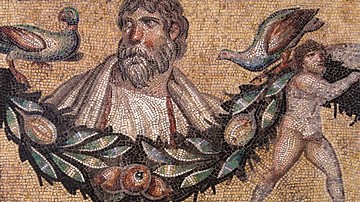In the second year of the Peloponnesian War, 430 BCE, an outbreak of plague erupted in Athens. The illness would persist throughout scattered parts of Greece and the eastern Mediterranean until finally dying out in 426 BCE. The origin of the epidemic occurred in sub-Saharan Africa just south of Ethiopia. The disease swept north and west through Egypt and Libya across the Mediterranean Sea into Persia and Greece.
The plague entered Athens through the city's port of Piraeus. The Greek historian Thucydides recorded the outbreak in his monumental work on the Peloponnesian War (431-404 BCE) between Athens and Sparta. According to various scholars, by its end, the epidemic killed upwards of one-third of the population; a population which numbered 250,000-300,000 in the 5th century BCE. By most accounts, the plague which struck Athens was the most lethal episode of illness in the history of Classical Greece.
Thucydides' Description of the Plague
Thucydides, in the History of the Peloponnesian War, paused in his narrative of the war to provide an extremely detailed description of the symptoms of those he observed to be afflicted; symptoms he shared as he, too, was struck by the illness. Despite his lack of medical training, Thucydides provided a vivid account of a variety of ailments that afflicted the diseases:
Violent heats in the head; redness and inflammation of the eyes; throat and tongue quickly suffused with blood; breath became unnatural and fetid; sneezing and hoarseness; violent cough' vomiting; retching; violent convulsions; the body externally not so hot to the touch, nor yet pale; a livid color inkling to red; breaking out in pustules and ulcers. (2.49-2.50)
Thucydides further described patients whose fever was so intense that they preferred to be naked than wearing any clothing that touched their skin; some even preferred to be submerged in cold water. Thucydides observed that the ill were "tormented by an unceasing thirst" which was not satiated regardless of the amount of liquids consumed. Many of the sick found it difficult to sleep, instead, displaying a constant restlessness. Many of the sufferers died within 7-9 days from the onset of symptoms.
If the ill were fortunate enough to live beyond the initial period of the infection, Thucydides observed that the patient suffered from "violent ulceration" and severe diarrhea usually resulting in their death. Those who survived the full run of the illness often suffered from disfigurement of their genitals, fingers, and toes (which were sometimes lost), blindness, and memory loss (of others as well as themselves). Thucydides noticed that in some instances birds and other animals which usually fed on human flesh were repulsed by the diseased bodies or died themselves from consuming the diseased and rotting flesh.
Which Disease?
For nearly 2500 years, historians and scholars have attempted to identify exactly what disease swept Athens resulting in so many deaths. Thucydides, not trained in medicine, did not specify an exact illness only a description of the various symptoms, people's reactions to being sick, and outcomes of the course of the disease. He did note that physicians attempted numerous cures and remedies which failed. The doctors were also some of the earliest casualties due to their repeated contact with those who had fallen ill from the disease, thus suggesting that whatever the disease, it was contagious. In the heat of war, it was suggested that the water drawn from local wells had been poisoned causing even men in the prime of health to become suddenly afflicted.
J. F. D. Shrewsbury - Measles
In just the last 60 years, the plague which struck Athens has been identified as one of a dozen infectious diseases. J. F. D. Shrewsbury, in The Plague of Athens, identified the disease as being "new" to Athens. Thucydides suggested that Greek physicians did not recognize the illness which struck the population. Thucydides' reason for describing the symptoms was to allow future people to recognize the illness, should it ever strike again. Shrewsbury provides a list of opinions from the 1940s attempting to identify the disease. Typhus, typhoid, smallpox, bubonic plague, and a combination of the aforementioned were all offered as the culprit.
Smallpox emerged as the most likely culprit, followed by typhus and bubonic plague. Shrewsbury eliminated smallpox as people stricken with that illness would not be capable of physically moving from their beds much less throw themselves into cold water as Thucydides remarked some did. Nor does Thucydides describe any backaches, a symptom specific to the early onset of smallpox.
Typhus was eliminated as there appeared to be no critical amount of black rats carrying the lice nor was any evidence offered that Athens or its citizens lived in dirt and squalor, lacked basic personal hygiene (bathing or clean clothes) to support lice. Deafness, rather than blindness, which afflicted the sufferers of Athens, is another tell-tale symptom of typhus.
Bubonic plague was dismissed just as easily due to a lack of evidence showing the presence of black rats which carried the fleas containing the Yersinia pestis microbe. Pneumonic plague was likewise discarded as the source of the illness as Thucydides failed to mention coughing or spitting of blood, symptoms commonly associated with that deadly infection. Typhoid fever, a waterborne illness, was also eliminated due to Thucydides' failure to describe polluted waterways or any patients suffering from rectal bleeding. Finally, Shrewsbury settled upon measles as the primary disease. The virulence of the disease suggested its "newness" to Athens along with Thucydides' description of common measles symptoms such as blindness, diarrhea, gangrene, sneezing, fever, and thirst.
D. L. Page - Measles
D. L. Page's article, "Thucydides' Description of the Great Plague at Athens," reached the conclusion that a virulent form of measles swept through Athens. The diagnosis of measles was based upon two sets of descriptions from Thucydides' account. The first set of descriptors included patients who remained mobile in the early onset of the illness; there was no mention of dysentery or mental incapacities such as delirium or coma although some patients appeared depressed. Based upon the translation of Greek terms and vocabulary used by Thucydides, the second set of descriptors indicated no period of incubation with the illness striking immediately and peaking within 7-9 days. In the event the patient survived, lesions appeared on the intestines accompanied by weakness and diarrhea. Memory loss, blindness, and gangrene soon followed. Thucydides noted that the illness appeared to be new to Athens. If so, then measles seemed the likely culprit based upon a side-by-side comparison between modern descriptions of a measles outbreak and Thucydides' record. Smallpox, typhus, bubonic plague, and typhoid were eliminated from consideration due largely to inconsistent symptomology and the rapid onset of Athens' plague.
W. P. McArthur - Typhus
W.P. McArthur disagreed. In "The Athenian Plague: A Medical Note", he identified typhus as the possible illness. Earlier scholars argued that before a diagnosis of typhus could be reached, Athenians needed to be in regular contact with black rats. McArthur replied that typhus was not spread by rats but by lice. Additional symptoms, as described by Thucydides, which suggested typhus as the culprit included some degree of mental impairment, incredible thirst, delirium, increased levels of strength and endurance, hallucinations, bleeding, bluish tone to the skin, convulsions, diarrhea, blindness, and the loss of fingers & toes.
P. Salway & W. Dell - Ergot Toxin
Due to the lack of consensus and contradictory conclusions of various scholars, P. Salway and W. Dell's "Plague at Athens" continued the discussion as to the nature of the illness which struck Athens. Recognizing Thucydides as the sole source of information describing the epidemic in Athens, the authors drew readers to the specific symptoms offered by Thucydides. The multiplicity of symptoms made it difficult to draw any firm conclusion. The fevers, mental disturbances, intestinal bleeding, and gangrene suggested many possibilities for the source of the condition. Of particular interest was that birds and animals were harmed by contact with the dead, diseased corpses. All infectious diseases were ruled out as the symptoms fit no known diseases. 
Salway and Dell turned their attention to food and water as the possible sources for the illness. Water was eliminated as soldiers fighting the war, who were away from Athens, were affected by the epidemic. This left polluted grain as the likely culprit. Specifically, the toxin ergot, taken in small or large doses, could affect many people simultaneously. Early symptoms of ergot poisoning included depression, sweating, and abdominal pain with cramping along with a pale skin hue, cold extremities, and neck pains. As the illness progressed, insomnia, internal burning sensations, and leg cramps afflict the sufferer. At its most severe point, ergot produced delirium, spasms and convulsions, gangrene, severe diarrhea, blisters on hands and feet accompanied by large, purple discolorations. Earlier scholars suggested ergot, but their diagnoses were relegated to footnotes. The disruption and destruction of harvests and fields suggested that the affected grain and flour may have come from Thrace or Attica.
C. H. Eby & H. D. Evjen - Glanders
In "The Plague at Athens: A New Oar in Muddied Waters," Clifford H. Eby and Harold D. Evjen conceded that Thucydides' description of the outbreak's symptoms, resembling a number of known infectious diseases, would allow the reader to draw their own conclusion as to the precise disease affecting Athens in 430 BCE. The changing nature of the disease (both the particular disease and its symptoms can change over time) and the lack of knowledge about Greek medicine would make an exact diagnosis problematic. Eby & Evjen engaged in a novel approach to solving the mystery: they looked for a disease that was no longer present in European or American populations but whose symptoms matched those identified by Thucydides.
The authors focused particularly on Thucydides' claim about the absence of birds and animals which would normally prey on the corpses of humans. The one exception absent from Thucydides' account was the dog. In consultation with veterinarians, glanders was suggested to be the probable cause of the epidemic as it was common to both humans and canines. Glanders produced symptoms of rash, fever, lesions, coughing, nasal & eye discharges leading to septicemia followed shortly by death. According to Aristotle, the disease existed in the 4th century BCE but was eradicated from Europe and North America by the early 20th century CE.
Glanders occurs primarily in horses and mules but can be transmitted to humans via contact with the animal's infected nasal discharge or if humans share a contaminated water supply. Once one human contracts the disease, it can be rapidly spread to other people when the affected person sneezes or coughs. As the epidemic erupted in the midst of war, there were undoubtedly horses and mules stationed in and around Athens supporting the armies. Only a few infected animals, in close contact with humans and/or the water supply, could have caused the epidemic episode. Glanders is not always fatal; Thucydides reported some individuals who recovered from the illness, which conferred a degree of immunity on the survivors in the event of another outbreak.
R. J. Littman & M.L.Littman - Smallpox
Robert J. Littman and M. L. Littman's study, "The Athenian Plague: Smallpox," returned to a discussion of language and translation as precision in language and meaning affects any diagnosis. Furthermore, the authors argued that Thucydides identified symptoms, such as rash, that was incomplete and likely unimportant as well as thirstiness which is common to many infectious diseases. The Littmans eliminated any disease which was not contagious and produced immunity as described by Thucydides. Additionally, symptoms, especially minor ones, change from one outbreak to the next, nor does every person exhibit every symptom. Secondary infections, such as pneumonia, might confuse the layperson, someone like Thucydides, with primary symptoms.
In their attempt to re-evaluate Thucydides' description of the outbreak, both symptoms and course, these authors concluded that smallpox was the likely culprit. The various forms of plague (bubonic and pneumonic), typhoid, and ergotism were eliminated as suspects as ergotism is not infectious and Thucydides makes no mention of bubonic plague's tell-tale symptom of buboes in the armpits or groin. Typhus and measles were eliminated from consideration as the rash associated with both did not match Thucydides' description of the eruptions as blisters and sores. Also, smallpox pustules strike the extremities which neither typhus nor measles do. Thucydides described blindness as a consequence of the Athens' disease which is common to smallpox but not typhus or measles. Thucydides' description of memory loss complicates the diagnosis but encephalitis does result from smallpox and can produce memory loss. The loss of the use of fingers and toes, identified by Thucydides, was likely caused by gangrene which is a complication of a smallpox outbreak. The absence of any description by Thucydides of scars, most often associated as a lasting consequence of smallpox, resulted from Thucydides following the Hippocratic School of disease theory which emphasized prognosis, not diagnosis.
A. J. Holladay & J. C. F. Poole - Multiple Diseases
In "Thucydides and the Plague of Athens" A. J. Holladay and J. C. F. Poole argued that Thucydides' description of the outbreak in Athens simply did not match any modern diseases. All of the symptoms offered by Thucydides could fit nearly any disease provided a researcher was willing to ignore some of the symptoms. Moreover, both parasites and hosts evolve over time due to repeated exposure with both adapting in order to survive.
The authors discussed the various diagnoses and issues that arise with each. Smallpox was the most often suggested source of the epidemic. Smallpox is contagious and is accompanied by fever and rash resulting in a high mortality rate, however, survivors do acquire a degree of immunity from exposure. Thucydides' failure to mention pockmarks is problematic but does not necessarily rule out smallpox. His description of gangrene of the extremities is extremely rare in smallpox outbreaks. The only known host for smallpox is humans, yet Thucydides describes birds and animals, especially dogs, as succumbing to the disease in Athens. It is the low mortality rate that all but rules out smallpox as Thucydides suggests a rate of 25% among the soldiers but fails to mention the rate amongst children, especially those under 5, who are most likely to die.
In the case of bubonic plague, it remains a good candidate as it affects both humans and animals. The lack of any description by Thucydides of buboes and the need for fleas to transmit the disease rather than a human-to-human transfer diminishes the odds that the Athenian plague was the plague. Scarlet fever was ruled out as a source as it only affects humans, not animals as mentioned by Thucydides, and generally has a very low mortality rate (at least by the 20th century CE, although it could have been higher in earlier times). Measles was eliminated for the very same reasons, and, additionally, it usually only strikes in cities with very dense populations above 300,000 few of which existed in the ancient world. Typhus, both varieties, was ruled out because Thucydides described the rash of victims as small blisters and sores whereas typhus displays red spots but not blisters, and he indicated no mental symptoms frequently exhibited by sufferers of typhus. Athens was not on a central source but multiple wells so an outbreak of typhoid fever was rejected as a cause of the epidemic. Ergotism was ruled out as it is not contagious, does not cause immunity in survivors, and is not caused by the spread of microbes.

The possibility that the Athenian plague was a combination of diseases was a promising diagnosis especially if all of the other diseases, on their own, were ruled out as potential sources for the epidemic. Multiple diseases can and do exist simultaneously in any society, and surviving one disease does not guarantee that a person will survive other diseases present. The combination theory is questionable, however, due to Thucydides' suggestion that survivors gained immunity from the illness. Modern scholars, wrongly, assumed that the plague that afflicted Athens must also be a modern known disease. There is the likely possibility that the disease which scourged Athens is either extinct or, after 24 centuries, the microbe responsible has changed sufficiently, along with various symptoms, that it is simply not recognizable today. The question of what swept Athens in 430 BCE may be unanswerable if researchers are trying to match the ancient disease to versions of a modern illness.
J. Longrigg - Multiple Diseases
Responding to the various studies which identified the plague of Athens as possibly being one of at least a dozen known diseases, James Longrigg noted, in "The Great Plague of Athens," that in the early stages of many diseases, exact diagnoses are difficult to identify as the early symptoms are often common to many different infections. A diagnosis is made more complicated when the source of information is a second-hand literary account and when the author of said account, in this case Thucydides, was himself a victim of the disease.
Diseases which strike a virgin-soil population (a group of people not previously exposed to a particular disease) are often more virulent, which suggests that Thucydides may have been describing a new disease. The majority of terms used by Thucydides in his account were customary and usual medical terms used in the 4th and 5th centuries BCE. Thucydides' description does not suggest one specific disease but could apply to numerous diseases. Furthermore, since one disease can make any given population susceptible to other diseases, Longrigg concluded that it was foolish for modern medicine to try and pinpoint one exact disease as the cause of the Athenian epidemic.
J. A. H. Wylie & H. W. Stubbs - Bacterial Infection
In "The Plague of Athens: 430-428 B.C. Epidemic and Epizoötic," J. A. H. Wylie and H. W. Stubbs re-opened the possibility that the Athenian plague derived its origins from animals (epizoötic). They point to dogs and birds avoiding the human dead and becoming sick after contact with the dead. The cattle existing and remaining in the city seemed to both lengthen the time of the disease and its potency. The authors suggest that leptospirosis, a bacterial infection spread by dogs and cattle, exists in conditions prevalent in ancient Athens: high concentration of population, poor living conditions, and poor food supply.

Tularemia, another bacterial disease shared by animals and humans, could be easily spread by rodents and infect humans through a flea or tick bite, contact with infected animals, or contaminated water supplies. Most of Thucydides' description of symptoms could apply to these epizoötic diseases, discounting for those symptoms which are often common to a multitude of infections. While these diseases are far less severe today, largely due to the use of antibiotics, the conditions in ancient Athens in 430 BCE would have given rise to a more severe outbreak. Ultimately the passage of time causing the mutation of the bacteria or virus which struck Athens complicates a modern diagnosis.
D. M. Morens & R. J. Littman - A Respiratory Disease
Employing an epidemiologic approach and mathematical models to compare the plague of Athens with other previously described ancient epidemics, David M. Morens and Robert J. Littman's research in "Epidemiology of the Plague of Athens" limited the possible means of transmission, thus ruling out certain causes and diagnoses. According to the authors, there are three types of transmission: common source (originating in the food or water supply), person-to-person, and reservoir (epidemic spring from an animal, insect, or the environment). In order for the disease to spread as fast and wide while causing such widespread destruction of human life, the epidemic was most likely respiratory in nature, thus making an animal or insect reservoir the likely source. In this case, the epidemic in Athens was most likely an incident of typhus or smallpox both of which fit the description recorded by Thucydides.
J. M. H. Hopper - Lassa Fever
From its point of origin in Ethiopia, traveling along the Nile, J. M. H. Hopper's "An arenavirus and the plague of Athens" ruled out an insect carrier. Since the epidemic remained largely confined to Athens, not spreading throughout the rest of Greece, Hopper examined rats, mice, fleas, lice, and cockroaches as potential carriers. A small house rat, which contaminated food and dust with its urine, thus helping to create the conditions for person-to-person spread of the disease, was the most likely suspect for transmitting Lassa fever. First recognized in Nigeria in 1969 CE, Lassa fever displays most of the symptoms matching Thucydides' description: fever, chills, headache, nausea, and vomiting, raised bumps on the skin, oral ulcerations, rashes, and dizziness. Left untreated, Lassa fever can kill the sufferer within 7-26 days.
J. Bellemore, I. M. Plant & M. Cunnigham - Alimentary Toxic Aleukia
In "Plague of Athens—Fungal Poison?", Jane Bellemore, Ian M. Plant, and Lynne M. Cunningham returned to the possibility that the epidemic in Athens resulted from some type of fungal poisoning. An earlier suggestion of ergot poisoning was ruled out as that particular fungus occurs mainly on rye, which the majority of Athenians did not consume. Instead, Alimentary Toxic Aleukia (ATA) was offered as an alternative fungal poisoning as it resulted from contaminated wheat. The authors based their conclusion of the nature of the epidemic on a comparison of mortality rates of ATA which occurred in Russia in the 1930s and 1940s CE. Nearly 60% of the people who contracted the illness died from consuming the overwintered wheat.
ATA is not visible to the naked eye and can remain active in stored grain for up to seven years. The symptoms of ATA appear in about 2-3 weeks with death occurring within 6-8 weeks. The symptoms of ATA poisoning strongly match those described by Thucydides: burning sensation, swollen tongue, vomiting, diarrhea, stomach pain, headache, dizziness, fatigue, excess saliva, pains in the back and joints, hemorrhages on the skin, pustules, skin eruptions, bleeding from nose, mouth, and in the lungs, delirium, convulsions, depression, and disorientation. A complete recovery is possible from ATA poisoning provided the patient is not re-exposed to the toxic grain.

According to Diodorus Siculus, nearly 10,000 of the 420,000 folks camped inside the walls perished in the general population; a mortality rate of 2-5%. Of those in the wealthy class, 25-30% died. The lower death rate in the general population can be correlated to the fact that the lower classes ate mainly barley grain while the wealthy and the better-paid cavalry & hoplites could afford more expensive grains such as wheat. The time lag between the consumption of the poisoned grain and the onset of illness was not recognized by Thucydides and hence a fungal poisoning was not considered (fungal poisoning was not medically recognized until the 16th/17th centuries CE). Although poison had been considered previously as a possible cause of the epidemic in Athens, earlier scholars examined the water of Athens, not its food stores.
M. J. Papagrigorakis et al. - Typhoid
Recent research by Manolis J. Papagrigorakis et al., in "DNA examination of ancient dental pulp incriminates typhoid fever as a probable cause of the Plague of Athens," into the cause of the epidemic in Athens has been aided by the use of DNA analysis. Nearly 150 bodies were recovered from an ancient cemetery named Kerameikos in Athens in 1995 CE. The site has been linked to the Athenian plague during the Peloponnesian War. The mass burial contained enough bones and teeth to allow for DNA extraction, especially dental pulp, allowing for a more precise biomedical analysis of what happened in 430 BCE. The various stages of testing revealed that bubonic plague, typhus, anthrax, tuberculosis, cowpox, and cat-scratch disease were not the cause of the mass illness. A seventh test did reveal traces of typhoid fever in the three victims' teeth. Many of the symptoms described by Thucydides such as fever, rash, and diarrhea match present symptoms of typhoid although other characteristics described by Thucydides do not. That can be easily explained by the possible evolution of the disease over time.
Conclusion
The outbreak in Athens in 430 BCE remains a mystery. Among the many suggestions as the diagnosis has been ebola, typhoid, smallpox, measles, bubonic plague, cholera, influenza, ergot poisoning, and a host of animal diseases. The scientific and scholarly community has accepted none as the fatal disease. In addition, the description offered by Thucydides has come under question as to what some of the characteristics of the disease actually mean in translation. Furthermore, Thucydides has been under investigation both for his motive of including the disease episode in his book but also the fact that he was not a medical person of any sort and so his reliability in diagnosing the symptoms is questionable.
The recent uncovering of the mass graves dating from the ancient period offered new hope that a definitive diagnosis was at hand as the modern techniques of DNA analysis would finally lay to rest the nearly 2,000-year controversy. The DNA sample extracted from teeth suggested typhoid fever as the primary culprit, but soon after the results were announced, this diagnosis was called into question by other scientists who argued that the methodology used was flawed. DNA sampling is limited especially in the detection of viruses, which require an RNA test, but the viruses degrade quickly over time making the probability of ever discovering what happened in Athens extremely unlikely.









